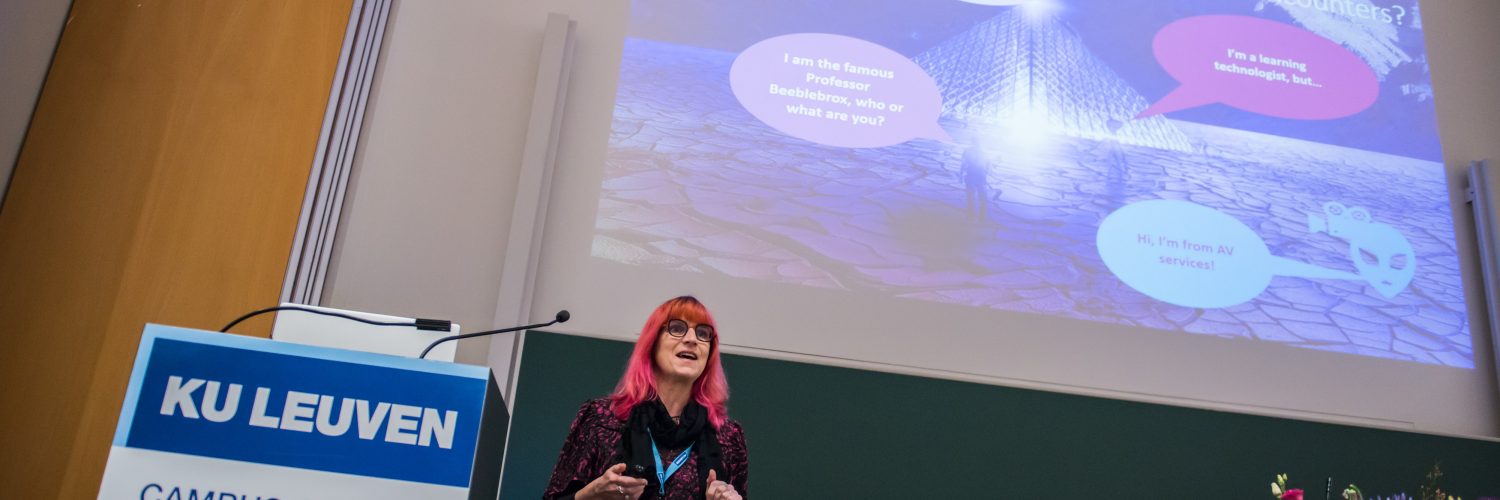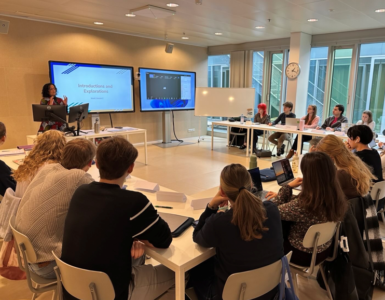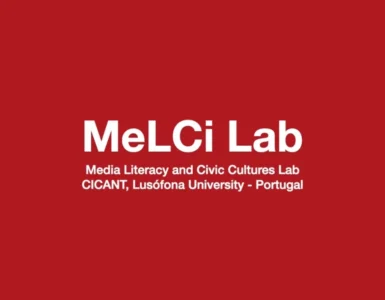By Deborah Arnold, AUNEGe, France
Keynote delivered at the Media and Learning Conference, Leuven, Belgium, June 2nd 2022
Let me take you on a journey into third space. If you’re not familiar with the term, I hope this talk will enlighten you, and provide you with food for thought. Here we are, on planet Academia. We have a professor… who comes across a strange alien figure, the learning technologist… They are just about to start a conversation, but then the team from the Centre for Teaching and Learning come in to land, followed swiftly by the audiovisual technician! How well do these different creatures know each other, what they do on Planet Academia? And how can we help them understand each other better, and their roles in improving learning and teaching with the use of media and technology?
Luckily, in the wasteland, a flower grows, the DELLHE flower… DELLHE stands for Digital Education Leadership Literacies in Higher Education, which was the topic of the PhD that I defended earlier this year (Arnold, 2021). The DELLHE framework represents the five dimensions of leadership attitudes, mindsets and behaviours that higher education leaders, at all levels of the organisation, need to develop in order to take a more strategic approach to digital education. As today we are focusing on the concept of Third Space, the most relevant dimension is that of the Relational Leadership Literacies, which concern both interpersonal relationships and organisational dynamics.
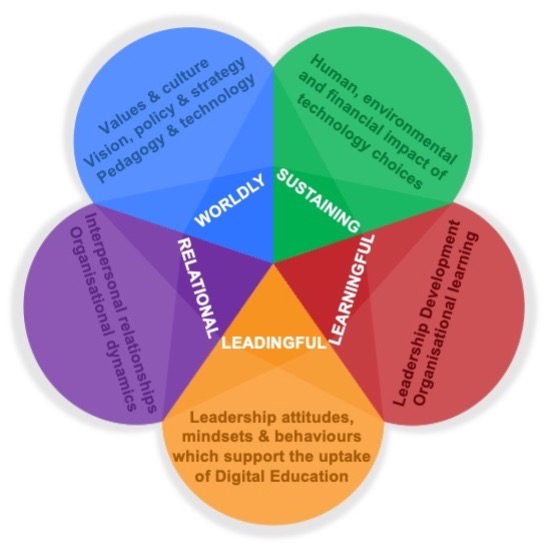
So let’s take a closer look at the notion of third space. And to do that we need to go into a bit of theory. Third space is grounded in Celia Whitchurch’s work, which goes back over a decade (Whitchurch 2008, 2018). Whitchurch frames this as that space in which academics and professional staff come together: in our example, our famous Professor Beeblebrox, the learning technologist, the team from the Centre for Teaching and Learning, the AV team.
But third space is not about structures and job titles, though they are important, it’s about how we work and who we work with. And leadership theory can help us understand this even more deeply, in particular Distributed Leadership (Spillaine, 2006), leadership as practice (Youngs, 2017) and relational leadership (Uhl-Bien, 2006).
Others have taken up Whitchurch’s work, to define third space as where “professional staff engage in leadership activity based on their expertise, particularly in learning and teaching support areas” (Bolden et al., 2015, p. 7) or which “sees professional staff and academics collaborating as they align learning and teaching and research quality to strategic aims and accountability” (Jones et al., 2014, p. 425). Learning technologists and educational developers, by the very nature of their work, can and should exist in this third space.
This recent book is an excellent resource for helping us understand third space better.
Remember, third space is not about structures and job titles, it’s about the spaces we occupy, the knowledges we create, the relationships we build and nurture, and the legitimacies we hold. The third space professional engages in blended, integrated practice.
What are the spaces we occupy?
Although we said third space wasn’t about structures, the spaces we occupy are often defined by the way in which our universities are organised. In this survey of 682 learning technology and audiovisual staff in French universities, about a third worked in units which were part of a digital directorate or information systems department, and a quarter were housed in an educational development unit or education and training directorate. However, we can see the very disparate locations ranging from direct reports to Vice-Rectors, Central services and over 20% who answered ‘other’.
But as we’ve seen, third space is also about working across silos, breaking down those traditional barriers. And if we go back to one of Whitchurch’s (2008) first framings of third space, we see professional staff roles on the left, which can be generalist, specialist or niche roles, and academic roles on the right. This is simply a proposal for framing these roles, it may well be different in your organisation, but thinking about this can help us see where we’d like things to be.
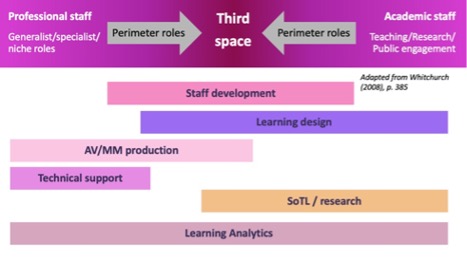
What might third space actually look like?
We’ve all seen images of futuristic learning centres… but what makes them third space is the people they bring together and what happens in them.
Take this example of the Learning Hub at the University of Northampton. It houses the library, the learning and teaching research institute, social spaces and coworking spaces. At Northampton, no one has an office, not even the Vice-Chancellor. So in the same building, we find academic staff, educational developers, learning technologists and students.
We have a purpose built physical third space designed to support interaction. The presence of the research institute helps to generate internal evidence of what works in digital education, to convince the more sceptical staff. And at the time I did this case study in 2019, there was a growing perception of students as partners.
But not every university is located on a single campus, with the funds to construct such a building. So third space can also be conceptual as exemplified by the Leuven Learning Lab here at KU Leuven. Here there was no restructuration of professional services, rather we have a networked structure as strategic concept to support the vision of a self-steering organisation. Incentives come in the form of additional funding for faculty groups if they work cross-group on strategic projects.
What are the knowledges we create in this third space?
In our conversations and collaborations, we create knowledge about learning and teaching and about media and technology. We create knowledge about each other and about learners. And we also create knowledge about ways of working together, and context, culture and values.
What are the relationships we build and nurture?
Here, the RELATIONAL dimension of the DELLHE framework (Arnold, 2021) provides us with some of the attitudes and mindsets which come into play, as well as the associated behaviours and actions of Digital Education leadership at all levels within the institution.
Attitudes and mindsets
- Understanding institutional dynamics
- Understanding the strategic potential of third space
- Trust
- Recognising the importance of building relationships
Behaviours and actions
- Fostering a culture of inquiry, innovation and collaboration
- Facilitating the creation of shared meaning
- Reaching across institutional silos
The importance of building relationships over focusing on technology was stressed by this head of the learning technology team in a UK university.
“We know how the tech works…, what we need to do is build relationships with people.”
Across the three case studies conducted in France, Belgium and the UK, both learning technologists and educational developers saw themselves as coaches, governance members used terms such as facilitator and conduit, and McIntosh and Nutt (2022) talk of ‘complex collaboration champions’. In a recent blogpost, Anne-Marie Scott highlights the need to replace control with trust, and the challenge that brings to institutional culture.
“Embracing digital transformation at scale is deeply uncomfortable though because it requires switching control for trust, and doing more of that investing in people and working together stuff.”
And so to the fourth and final aspect of third space we are examining this morning.
What are the legitimacies we hold?
As third space professionals, our background will influence not only our professional identity, but also how our role is recognised within the institution. One way to clarify our identity is to tell our stories and trajectories, for example through what Pip MacDonald frames as ‘techno-auto-ethnographies’.
In terms of identity, or more precisely multiple identities, here are a few of the job titles and roles I’ve held over the years, as well as my fields of study. My identity is clearly grounded in teaching, although I’ve never held a formal academic role in higher education. Media and technology for learning and teaching have been with me since the start of my career, when I was using Computer Assisted Language Learning back in the 1990s. Project management and team management also continue to feature strongly in my identity in both my formal professional role and teaching activity, with this evolving into a focus on leadership, which ultimately became the topic of my research. These identities are multiple and overlapping, the boundaries are fuzzy, and they are constantly shifting.
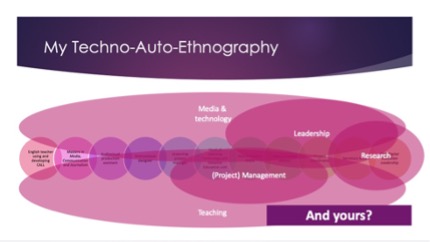
Take a moment to think about your own techno-auto-ethnography.
In the 2021 ALT survey of mainly UK-based learning technologists, the primary functions of learning technologist roles evolved between 2019 and 2020, with less emphasis on technical support, and an increase in teaching, leadership and staff development roles.
Now it’s time for us to return to the issues for leadership and leadership development that we identified in our research, as a series of questions that we need to ask.
Drawing on the Relational dimension:
- How do we build and maintain relationships around Digital Education?
- How do we foster a climate of trust?
- How can we improve shared understanding of Digital Education?
- How can we work better across traditional boundaries?
And then taking a closer look at the Learningful dimension, which concerns both individual leadership development but also organisational learning.
- Who do we want to develop as Digital Education leaders and how do we support them?
- How do we develop a culture of innovation?
- How do our physical and digital spaces support organisational learning?
It is reassuring to know that we are not alone, and that that are many national and international networks which support third space professionals, a few of which are listed here. We need to work together more than ever, to continue breaking down silos, building trust and developing a shared vision for Digital Education.
Thank you for joining me on this journey through third space. I hope you enjoyed the ride!

Author
Deborah Arnold, AUNEGe, French Digital University for Management and Economics, France

